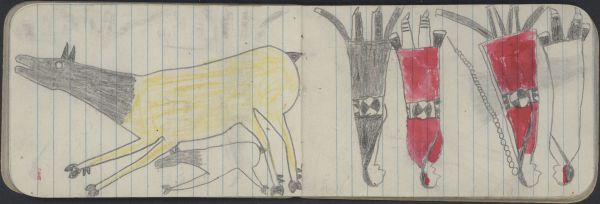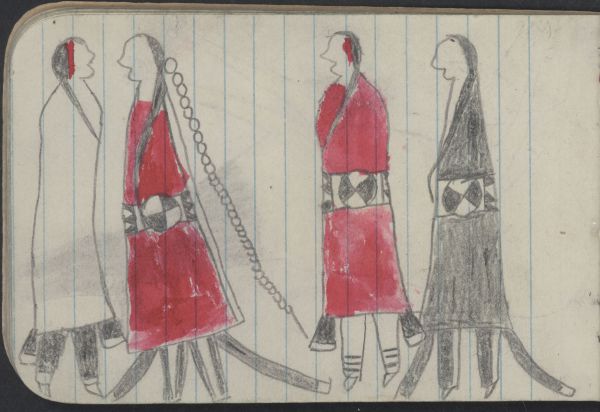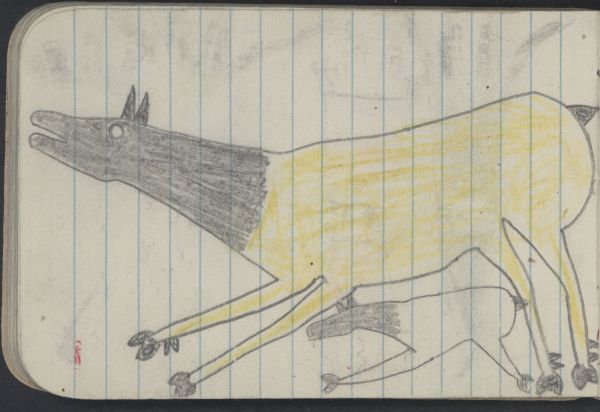ANIMALS, ELK; COURTING, TWO COUPLES
Ethnographic Notes
46 Female and Calf. Adult female and her calf run from left to right across the page. The adult is outlined and fully colored, with detailing of ears, split hooves, dew claws, and tail. The eye is an unpigmented circle that contrasts with the hide. The front legs are down, indicating motion. The head and neck extend and lift upward. Between her legs, in the same composition as the female buffalo and calves in this ledger, is a small calf. The calf may be alongside her, as ledger art telescopes distances. The calf is mostly an outlined shape with no coloring, except for darker fur around its head and neck. Its ears, split hooves, and tail are detailed. It has no eyes. This drawing is almost identical to the sequence of other female elk with calves in this ledger: plates 25-31. Minor variations do occur. Several implications arise with this drawing of a female elk and calf. Elk were replacing buffalo on the plains as the largest game source at the time of the 1879 incarceration of the Northern Cheyenne men who drew this and related ledgers. The season for elk calving coincides with the months of incarceration, February through June. Respect for female reproductive powers are central to Cheyenne values. Peter J. Powell quotes Fire Wolf (1961): "The law is this: the woman is above everything because Maheo has given the woman power to spread people to cover the face of the earth" (1969: 444). This drawing is an elk, not a woman, but focus is on the newborn life. Elk have spiritual associations, as they can represent Maiyun, Above Powers, along with buffalo, bear, wolf, and swifthawk (Powell, 1969: 437-9). For further information about elk, see plate 19 notes. For further discussion buffalo and calves, see plate 11. 47 Two couples face each other on the page, with the men in the dominant right-hand positions. The first man has a tomahawk showing from under his blanket, one of the few appearances of this weapon in this and related 1879 Northern Cheyenne Dodge City ledgers. When Colonel Richard Irving Dodge wrote about Plains tribes, including the Cheyennes, in 1882, he noted: "Though there are yet many very elaborately ornamented tomahawks, they are regarded rather as an insignia of rank, to be carried on ceremonial occasions, but are scarcely thought of as weapons" (420). Formal COURTING is, indeed, ceremonial. The man wears a German silverplate hair ornament, with one immature golden eagle feather attached between the first and second hairplates down from his scalplock. His blue Lakota courting blanket has a distinct beaded medicine wheel strip. His dark clout, with undyed selvedge edges, extends to the ground. This is one of the few occasions when a man's leggings are banded, but these are broad bands, like those from Hudson�s Bay blankets cut so that the woven stripes create striped leggings. The women�s banded ankles are not so thick. The woman facing him appears in a Navajo chief�s blanket (third phase?), and her red facepaint extends along the visible hairline. Ends of red trade cloth dress panels show under her blanket, with undyed selvedge edges. Her uncolored legs or leggings end at four bands drawn around her ankles. The next man is identical to the first, except he has no tomahawk. His hairplate ornament is slightly shorter. Both men�s feet are crowded off the page and do not show. The final woman, facing the second man, wears a blue Lakota COURTING blanket with four-quartered medicine wheel design in the middle. She wears blue leggings with a row of white buttons or small German silver circular ornaments up the front vertical seam. Her red trade cloth dress panel ends show beneath the blanket, similar to the other woman�s. This is one of a sequence of drawings with similar composition (plates 19, 21-25). See plate 1 for further discussion of COURTING conventions.


